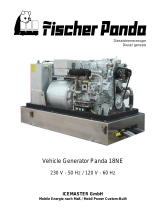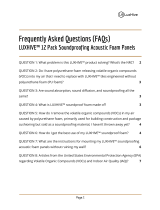Page is loading ...

INSTALLATION MANUAL
COD. 41098i
IS 11
IS 13.5
IS 15
IS 18.5
IS 21
IS 23
50 Hz
60 Hz
50 Hz
60 Hz
50 Hz
60 Hz

GENERATORS
- 2 -
Fig. 3
Nomefile: miis15US.pm5
Data di aggiornamento: 06/02/98
Redatto: Service Paolucci
Fig. 2
Fig. 1
1
3
2
4

GENERATORS
-
3
-
Fig. 4
Fig. 6
1
2
Fig. 5
Fig. 7
Fig. 8
11

GENERATORS
- 4 -
Fig. 10
Fig. 9
1
4
3
5
2
3
1
2

GENERATORS
-
5
-
Fig. 13
Fig. 12
Fig. 11
CARICO
LOAD
CHARGE
RETE
MAINS
RESEAU
GEN.
2
1
2
1
3

GENERATORS
- 6 -
Fig. 14
Fig. 15
1
6
5
4
6
1
2
3

GENERATORS
-
7
-
A statement advising of the need to take care lest there be serious consequences resulting in death
of personnel or in hazard to health.
A situation that could occur during the lifetime of a product, system or plant that has the potential
for human injury, damage to property, damage to the environment, or economic loss.
A statement advising of the need to take care lest serious consequences result in harm to material
items such as the asset or the product.
Important information.
Drawing are provided by way of example. Should your machine be quite different from the illustrations contained in
this manual, the safety regulations and relevant information are always granted.
The manufacturer's policy of constant development and updating may lead to modifications without prior notice.
CONTENTS
THE GUARANTEE OF THE PRODUCT BECOMES
VOID IF THE SPECIFICATIONS CONTAINED IN
THE FOLLOWING INSTALLATION MANUAL ARE
NOT RESPECTED
1 INSTALLATION .............................................8
1.1 Features of the room ......................................8
1.2 Securing the unit ............................................8
1.3 Ventilation .......................................................8
2 COOLING WATER CIRCUIT .........................8
2.1 Sea water conduction system .........................8
2.2 Standard installation of the generator above the
waterline .........................................................9
2.3 Standard installation of the generator below the
waterline .........................................................9
2.4 Components ................................................... 9
2.5 Exhaust/drainage system ...............................9
3 FUEL CIRCUIT ............................................10
3.0 Fuel circuit ....................................................10
3.1 Connections ................................................. 10
3.2 Supply system bleeding ................................10
4 POWER CONNECTIONS ............................10
4.1 Battery connection ........................................ 10
4.2 AC connection ..............................................11
4.3 Generator-mains switch ............................... 11
5 HANDLING .................................................. 11
5.1 Lifting ............................................................ 11
6 SOUNDPROOF CASING ASSEMBLY ........10
GB

GENERATORS
- 8 -
1 INSTALLATION
1.1 Room features
The generator must be installed in a well-ventilated room
able to ensure the small amount of air required for motor
combustion. This room must be separate and acousti-
cally isolated from living areas.
Position the generator so as to provide access for routine
maintenance jobs.
It is best to install the generator in the engine room as
long as this conforms to the above specifications.
Ambient temperature does not affect generator opera-
tion because the air intake to the motor and alternator fan
is previously cooled through a heat exchanger.
1.2 Securing the unit
To position the generator, provide a base able to with-
stand its weight. Drill the base in compliance with the
overall dimensions (see fig. 1) shown in the following
tables:
1.3 Ventilation
The generator features an internal closed-circuit ventila-
tion system which, by means of a sea water-air ex-
changer, cools the alternator and the air inside the
soundproof casing. This ventilation system does not
require air intake from the external environment.
The amount of air required for combustion passes through
four holes on the exhaust side (fig. 2 ref.1). Make sure
these holes are always free.
2 COOLING WATER CIRCUIT
The generator motor is cooled by the closed-circuit
circulation of liquid with liquid-sea water heat exchanger.
When installing, a sea water conduction circuit will have
to be set up for cooling as well as an exhaust/drainage
system for conveying combustion gases and cooling
water outside.
2.1 Sea water conduction system
Two water inlet systems are normally adopted on boats
(fig. 5)
1 - Direct intake system
2 - System with deflector
MASE recommends the direct intake system ref. 1 fig. 5
as this system prevents the entry of water under pres-
sure into the intake pipes when the boat is moving and
generates a vacuum which is easily overcome by the
head of the generator water pump.
Do not fit any type of protection
hood to the direct intake system.
The sea water intake system with deflector can on the
other hand cause the following problems:
a - Fitted with slots turned towards the prow
In this case, during sailing and with the generator
off, a pressure is created in the water intake pipe
which can cause the system to fill up until the motor
exhaust valves are reached, thereby making it
possible for water to enter the cylinders.
b - Fitted with slots turned towards the stern
In this case, during sailing, a vacuum can be
created inside the water intake pipe such as to
prevent the pump sucking up sea water or restrict
ing flow with consequent overheating of the gen
erator.
During testing of generator instal-
lation, it is always advisable to make sure, when the
boat is sailing, that there is no pressure in the
cooling circuit such as to cause the water to rise
towards the motor.
GENERATOR IS 21 - IS 23
Overall dimensions
( H - W - L )
mm
( inc )
800 - 670 - 1340
31.5 - 26.38 - 52.76
Drilling height
( A - B - C - D - E - F - G )
mm
( inc )
202-916-222-81-14-508-81
7.97-36-8.77-3.2-3.55-20-3.2
Weight (With soundproof casing)
Weight (Without soundproof
casing)
Kg
Kg
512
480
GENERATORS IS 15 - IS 18.5
Overall dimensions
( H - W - L )
mm
( inc )
730 - 650 - 1260
28.74 - 25.6 - 44.7
Drilling height
( A - B - C - D - E - F - G )
mm
( inc )
312-746-202-86-13-508-56
12.28-29.37-7.95-3.4-0.5-20-2.2
Weight (with soundproof casing)
Weight (without soundproof
casing)
Kg
Kg
410
380
GENERATOR IS 11 - IS 13.5
Overall dimensions
( H - W - L )
mm
( inc )
730 - 650 - 1135
28.74 - 25.6 - 44.68
Drilling height
( A - B - C - D - E - F - G )
mm
( inc )
277-652-206-86-13-508-56
10.9-25.67-8.1-3.4-0.5-20-2.2
Weight (with soundproof casing)
Weight (without soundproof
casing)
Kg
Kg
344
315
GB

GENERATORS
-
9
-
2.2 Standard installation of the generator above
the waterline (fig. 3)
1 Sea inlet (1")
2 Main system stopcock (1")
3 System drainage cock
4 Water filter
5 Generator unit
6 Silencer
7 Drain trap
8 Sea outlet pipe (3")
9 Waterline
A - 80 mm inner diameter pipe
B - 25 mm inner diameter pipe
C - Clamps
D - 80 mm inner diameter pipe
It is most important to keep to the
measurements shown in fig. 3
The silencer (fig .3 ref. 6) receives
the water in the drainage pipes, when the generator
motor is switched off, and prevents this flowing into
the motor through the manifold and drain valve. For
this reason, exhaust position and pipe length must
always be those shown on the installation diagram.
2.3 Standard installation of the generator below
the waterline (fig. 4)
1 Sea inlet (1")
2 Main system stopcock (1")
3 System drainage cock
4 Water filter
5 Anti-drain trap valve
6 Silencer
7 Muffler
8 Sea outlet pipe (3")
9 Generator
10 Drain pipe
11 Waterline
A - 80 mm inner diameter pipe
B - 25 mm inner diameter pipe
C - Clamps
D - 80 mm inner diameter pipe
It is most important to keep to the
measurements shown in fig. 4
2.4 Components
The sea water intake system must
be separate from that of the boat engines
1 - Direct-type sea intake 1"
In the event of the unit being
installed over 1 m above the waterline, a non-return
valve will have to be fitted after the sea intake (fig. 7
ref. 1) to prevent emptying of the cooling system
with the motor off. In the event of emptying, an
inspection should be made during generator startup
to check the damage to the sea water pump. For the
same reason, when starting up the generator, manu-
ally fill the valve-pump suction pipe.
2 - Ball cock (General system) 1"
3 - Ball cock (System drainage) 1"
This drains the generator cooling system for general
maintenance or long periods of inactivity
4 - Water filter (open to inspection)
This must successfully protect the cooling circuit from
mud, sand and algae.
Water flow capacity IS 11 15 21 = 40 l/min
Water flow capacity IS 13.5 18.5 23 = 45 l/min
The filter mesh must be fine. We
recommend using the 2 - 470 micron pitch type.
Different measurements do not offer good filter
performance.
5 - Anti-drain trap valve: this valves restores the switched-
off motor cooling circuit to atmospheric pressure, avoid-
ing any drain-trapping.
Use is mandatory when the base of the generator is
below the waterline. It must be positioned at least 30 cm
above sea level. (see fig.4)
The anti-drain trap valve must be
fitted between the sea water pump delivery head and
the mixer as shown in fig.8
The drainpipe of the anti-drain trap valve must nec-
essarily run below the valve thereby stopping water
from accumulating in the pipe which must always be
empty to allow air to pass through when the genera-
tor is switched off (see fig. 6)
Use the holes at the bottom of the soundproof casing to
access the inside with the anti-drain trap valve connec-
tion pipes (fig.2 ref.4)
It is best to bring the ant-drain trap valve drainpipe into
the bilge, as small quantities of water could leak out of
this during operation.
The cooling circuit must be connected to the exchanger
as shown in fig.9 ref. 1
Use the hole on the side wall of the soundproof casing to
access the inside with the sea water suction pipe (fig.2
ref.3)
2.5 Exhaust/drainage system
The generator combustion gas/water exhaust/drainage
system must be separate from that of the main motors.
Connect the 80 mm diameter pipe to the exhaust mani-
fold of the motor and secure carefully with a metal clamp.
Use the hole on the side of the soundproof casing to
access the inside with the exhaust pipe (fig.2 ref.4)
GB

GENERATORS
- 10 -
For more details, see the motor
manufacturer’s user and maintenance manual.
3.2 Supply system bleeding
After installing the generator, initial startup could prove
difficult and motor operation could be irregular due to air
bubbles inside the fuel system. This will therefore have
to be bled.
Loosen the screw on the fuel filter as shown in fig.9 ref.4
and subsequently act on the fuel pump lever until fuel
without air bubbles comes out. Retighten the screw.
If necessary, repeat the operation several times.
4 POWER CONNECTIONS
4.1 Battery connection
To start up the generator an independent 12 V, 100 Ah
battery is required.
The battery must not be below the
indicated capacity.
The battery must be connected to the generator using
leads with a cross section of no less than 25 sq mm up
to a distance of 4 m, with leads of cross section of no less
than 35 sq mm for greater distances. The operation
sequence is as follows:
- Connect the positive pole (+) of the battery to the
terminal on the starting motor (fig.11 ref.1)
- Next connect the negative pole (-) of the battery to the
motor casing (fig.11 ref.2).
- Cover the connections with specific mineral grease to
reduce oxidation or corrosion.
The generator features an electronic device for auto-
matic recharging of the starting motor. This produces
15 A at a 12V battery voltage IS 11 - 13.5 - 15 - 18.5 end
40 A. IS 21 - 23.
Install the battery in a well-venti-
lated environment, separated from the generator
and any devices likely to produce heat or sparks.
Periodically check the condition of the terminal
connections and the level of the electrolyte in the
battery. In the event of it being necessary to discon-
nect the leads, proceed in the reverse sequence to
that suggested for connection. Never invert the
connection lead poles - the generator and battery
could be seriously damaged.
Never connect other loads to the battery.
The length of the pipe from the
highest point of the exhaust pipe to the silencer
must not exceed 2 m. This prevents any water in the
exhaust pipe, when the generator is switched off,
from flowing into the motor once the silencer is full.
1 - Silencer
This curbs the noise of the exhaust and prevents water
flowing back to the motor. The silencer is best fitted no
further than 1 m from the generator and positioned at the
height shown in fig. 3/4
2 - Muffler
This further reduces noise. The muffler is best installed
no further than 1 m from the sea outlet pipe.
3 - Sea outlet pipe
This should be installed so it is always above the waterline
in all sailing conditions.
3 FUEL CIRCUIT
The motor of the generator unit runs on diesel fuel. Two
different pipelines will have to be fitted; one for the fuel
supply and the other for the reflow of the excess fuel into
the tank. A water/diesel fuel separator filter is best fitted
to the fuel supply line, between the tank and the genera-
tor, to prevent any water/diesel oil mixture damaging the
motor. A non-return valve is best fitted when the tank is
at a lower level than the fuel pump (fig. ref.) to prevent the
emptying of the fuel system. Use a valve with 50 millibar
opening
The difference in level between
the tank and the generator fuel pump should not
exceed 7 cm. In the event of this level being greater,
it is best to fit an electric fuel pump near the tank to
overcome this level difference.
The fuel pipes must be made of hydrocarbon-resistant
rubber and have an internal diameter of 8 mm.
3.1 Connections
The fuel supply pipe must be connected to the suction
union of the AC pump of the motor (fig. 9 ref.2) and the
return pipe must be connected to the union on the fuel
filter (fig.9 ref.3). Fit the pipes to the unions using metal
clamps so as to prevent air bubbles from entering the
supply system or fuel from escaping.
Use the holes on the bottom of the soundproof casing to
access the inside with the fuel pipes (fig.2 ref.4)

GENERATORS
-
11
-
In order to keep galvanic currents down to a minimum,
the negative (-) pole of the generator unit must not be
connected to the negative (-) pole of other batteries on
board.
4.2 A.C. Connection
This connection can be made by means of the power
terminals on the alternator of the generator unit (fig. 10
ref. 1). Access to this terminal board can be achieved
after removing the closing panel as indicated in fig. 2 ref.2
and cover fig.10 ref.3.
This range of generators can be used at either 115V - 50
Hz / 120 V - 60 Hz or 230V - 50 Hz / 240V - 60 Hz.
Two types of connection (and consequently use) are
therefore possible, according to the following configura-
tions:
1 - In parallel connection: in this configuration, there
is just one 115 (120)V output between points 11 and 4
connecting the alternator outputs (33 - 11 and 2 - 4) as
shown in the diagram in fig. 13 ref. 2.
2 - In series connection: in this configuration power
output can be 230 (240) V between points 11 and 4 as
shown in the diagram in fig.13 rif. 1.
In the case of the in-series connection, voltage can be
either 115 (120) V between 3 - 1 and 2 - 4 or 230 (240)
V between points 11 and 4 as shown in the diagram in fig.
13 ref. 3.
If the in-series connection is se-
lected (Fig. 13 ref. 3) with 115 V 50 Hz - 120 V 60 Hz
voltage, current should not exceed 50% rated.
- To achieve both in-parallel and in-series connections
use jumpers on terminal board fig. 10 ref. 1
- Make sure that the sum of the loads to be supplied is not
greater than the rated power of the generator.
- The generator features an overload cutout which inter-
rupts power supply in case of overloads or short-circuits.
4.3 Generator - mains switch
A switch must be fitted to the line so that utilities can be
switched from the generator to a mains power supply.
This switch must be sized according to the loads in-
volved: a standard diagram is shown in fig.12.
GB
5 HANDLING
5.1 Lifting
To handle and lift the generator unit, use only the
specially set lifting hook provided (fig. 15 ref. 1)
Hooking the generator unit to
points other than those indicated could damage the
unit itself and be dangerous for operators.
6 SOUNDPROOF CASING ASSEMBLY
The generator units of the IS 1500 rpm series can be
used with or without the soundproof casing. Configura-
tion without the soundproof casing features a wood base
and dashboard support as represented in fig.9
Should you wish to further soundproof the generator unit,
a specially designed soundproof cabin is available for the
purpose.
To install the soundproof cabin, proceed as follows:
- secure the clamping brackets (fig.14 ref. 1-2) and two
sides to the wood base using the screws provided, as
indicated in fig.14 ref. 3.
- Secure the two end sides to the wood base as indicated
in fig.14 ref. 4-6.
- Secure the upper crosspiece to the two end sides, fig.14
ref.5.
- Secure the two doors by means of the rubber straps
provided fig. 14 ref.6.
/


